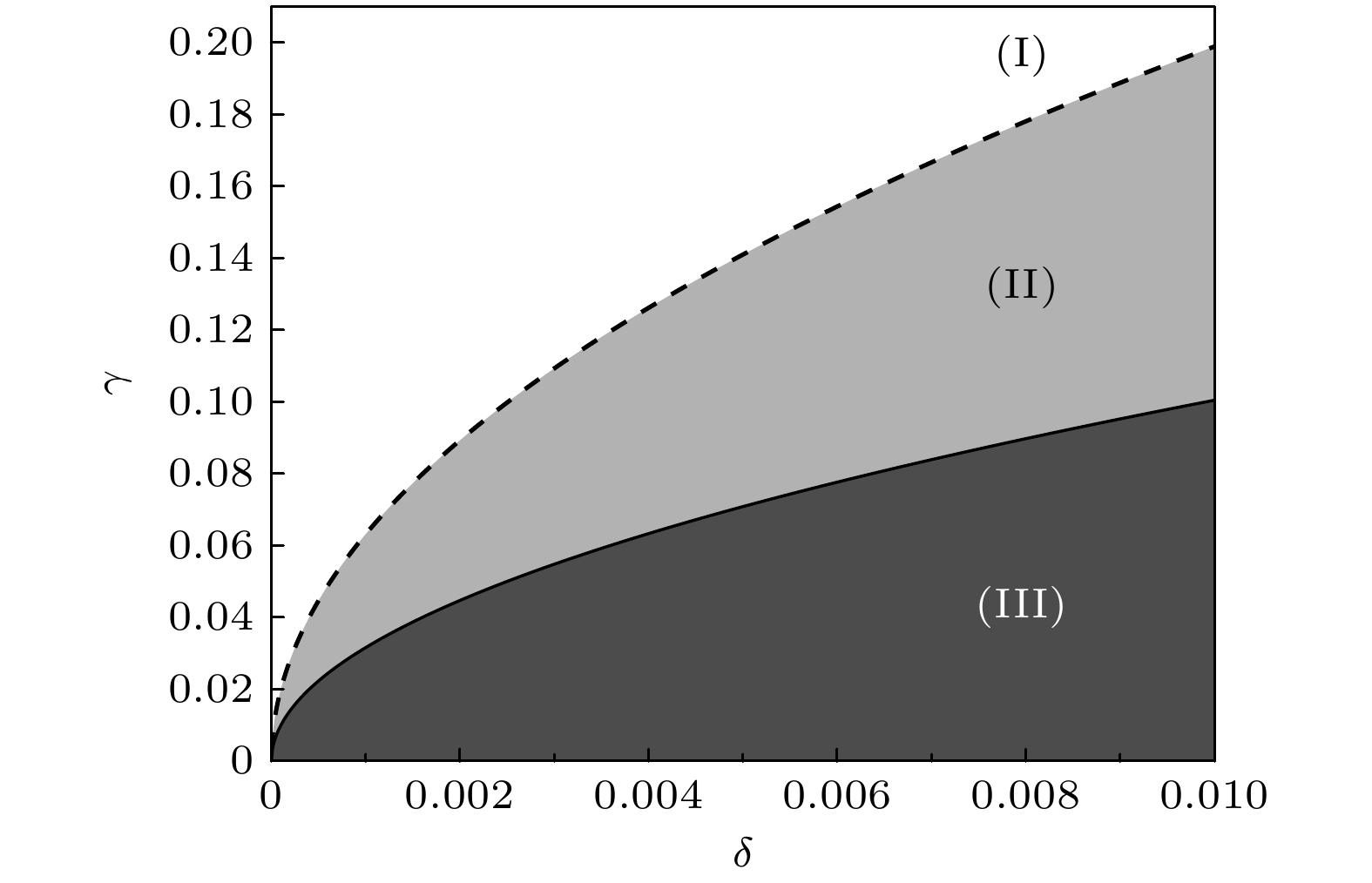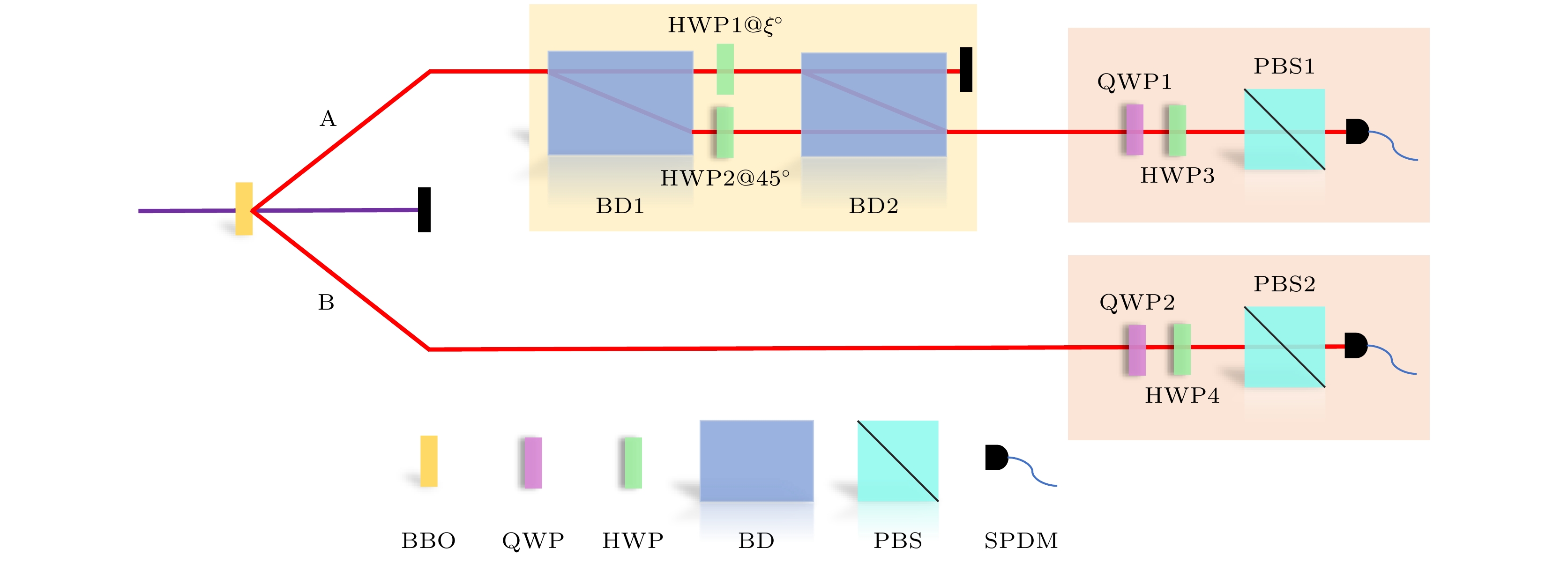-
纠缠是量子理论中一种独特的现象, 揭示了经典物理与量子物理之间的根本差异. 虽然在微观尺度上已经观察到许多纠缠现象, 但当涉及大尺度系统的相互作用时, 纠缠往往非常微弱, 此时实验设备的误差可能掩盖微弱信号, 导致纠缠难以测得. 为了提升对微弱纠缠信号的检测灵敏度, 最近提出了一种基于量子导引的弱纠缠判据, 可以有效地检测微弱的纠缠态. 本文在理论上证明了该判据相比于传统纠缠目击者判据在弱纠缠检测能力方面具有明显优势. 此外, 通过光学实验验证了这一判据的可行性, 实验结果为其有效性提供了关键支持, 并展示了该判据在弱纠缠态检测中的创新性和可靠性. 该判据作为一种有效的弱纠缠检测手段, 有望在量子通信、量子计算等量子技术领域中得到广泛应用.Quantum entanglement is a unique phenomenon of quantum mechanics and the core of many quantum technologies. Although entanglement is often observed in small-scale systems, detecting weak entanglement in large or noisy systems remains a major challenge, as experimental flaws can easily destroy fragile quantum correlations. A new weak entanglement detection criterion based on quantum steering has recently been proposed as a potential alternative to traditional entanglement witnesses. In this work, we provide a theoretical analysis by comparing the detection capabilities of the steering-based criterion with those of traditional entanglement witnesses under realistic measurement errors. The results show that the steering-based approach offers improved sensitivity for detecting weak entanglement. We further experimentally verify the feasibility of this steering-based criterion by using a linear optical setup. The experimental results align well with theoretical predictions, confirming the practicality and reliability of the method. These findings provide the steering-based criterion as a promising and accessible tool for detecting weak entanglement, and are expected to have potential applications in quantum communication, quantum computing, and other areas of quantum information science.
[1] Bell J S 1964 Physics Physique Fizika 1 195
 Google Scholar
Google Scholar
[2] Aspect A, Dalibard J, Roger G 1982 Phys. Rev. Lett. 49 1804
 Google Scholar
Google Scholar
[3] Weihs G, Jennewein T, Simon C, Weinfurter H, Zeilinger A 1998 Phys. Rev. Lett. 81 5039
 Google Scholar
Google Scholar
[4] Horodecki R, Horodecki P, Horodecki M, Horodecki K 2009 Rev. Mod. Phys. 81 865
 Google Scholar
Google Scholar
[5] Leibfried D, Knill E, Seidelin S, Britton J, Blakestad R B, Chiaverini J, Hume D B, Itano W M, Jost J D, Langer C, Ozeri R, Reichle R, Wineland D J 2005 Nature 438 639
 Google Scholar
Google Scholar
[6] Lu C Y, Zhou X Q, Gühne O, Gao W B, Zhang J, Yuan Z S, Goebel A, Yang T, Pan J W 2007 Nat. Phys. 3 91
 Google Scholar
Google Scholar
[7] Rijavec S, Carlesso M, Bassi A, Vedral V, Marletto C 2021 New J. Phys. 23 043040
 Google Scholar
Google Scholar
[8] Tilly J, Marshman R J, Mazumdar A, Bose S 2021 Phys. Rev. A 104 052416
 Google Scholar
Google Scholar
[9] Marshman R J, Mazumdar A, Bose S 2020 Phys. Rev. A 101 052110
 Google Scholar
Google Scholar
[10] Cataño-Lopez S B, Santiago-Condori J G, Edamatsu K, Matsumoto N 2020 Phys. Rev. Lett. 124 221102
 Google Scholar
Google Scholar
[11] Matsumoto N, Cataño-Lopez S B, Sugawara M, Suzuki S, Abe N, Komori K, Michimura Y, Aso Y, Edamatsu K 2019 Phys. Rev. Lett. 122 071101
 Google Scholar
Google Scholar
[12] Lambert N, Chen Y N, Cheng Y C, Li C M, Chen G Y, Nori F 2013 Nat. Phys. 9 10
 Google Scholar
Google Scholar
[13] Cao J, Cogdell R J, Coker D F, Duan H G, Hauer J, Kleinekathöfer U, Jansen T L C, Mančal T, Miller R J D, Ogilvie J P, Prokhorenko V I, Renger T, Tan H S, Tempelaar R, Thorwart M, Thyrhaug E, Westenhoff S, Zigmantas D 2020 Sci. Adv. 6 eaaz4888
 Google Scholar
Google Scholar
[14] Engel G S, Calhoun T R, Read E L, Ahn T K, Mančal T, Cheng Y C, Blankenship R E, Fleming G R 2007 Nature 446 782
 Google Scholar
Google Scholar
[15] Bose S, Mazumdar A, Morley G W, Ulbricht H, Toroš M, Paternostro M, Geraci A A, Barker P F, Kim M S, Milburn G 2017 Phys. Rev. Lett. 119 240401
 Google Scholar
Google Scholar
[16] Marletto C, Vedral V 2017 Phys. Rev. Lett. 119 240402
 Google Scholar
Google Scholar
[17] Nguyen H C, Bernards F 2020 Eur. Phys. J. D 74 69
 Google Scholar
Google Scholar
[18] Chevalier H, Paige A J, Kim M S 2020 Phys. Rev. A 102 022428
 Google Scholar
Google Scholar
[19] Miki D, Matsumura A, Yamamoto K 2021 Phys. Rev. D 103 026017
 Google Scholar
Google Scholar
[20] Feng T, Vedral V 2022 Phys. Rev. D 106 066013
 Google Scholar
Google Scholar
[21] Chen J L, Su H Y, Xu Z P, Pati A K 2016 Sci. Rep. 6 32075
 Google Scholar
Google Scholar
[22] Feng T, Ren C, Feng Q, Luo M, Qiang X, Chen J, Zhou X 2021 Photonics Res. 9 992
 Google Scholar
Google Scholar
[23] Cao H, Morelli S, Rozema L A, Zhang, C, Tavakoli A, Walther P 2024 Phys. Rev. Lett. 133 150201
 Google Scholar
Google Scholar
[24] Morelli S, Yamasaki H, Huber M, Tavakoli A 2022 Phys. Rev. Lett. 128 250501
 Google Scholar
Google Scholar
[25] Shih Y H, Sergienko A V 1994 Phys. Rev. A 50 2564
 Google Scholar
Google Scholar
[26] Kwiat P G, Waks E, White A G, Appelbaum I, Eberhard P H 1999 Phys. Rev. A 60 R773
 Google Scholar
Google Scholar
-
图 1 基于量子导引与基于纠缠目击者的量子纠缠判据比较. (I)为基于量子导引和基于纠缠目击者两种判据都可以检测到量子纠缠的区域; (II)为基于量子导引判据可以检测到量子纠缠的区域, 此区域基于纠缠目击者判据无法检测出量子纠缠; (III)为两种判据都无法检测出量子纠缠的区域. $ \gamma $为纠缠程度参数, $ \delta $为测量精度参数
Fig. 1. Comparison of quantum entanglement criteria based on quantum steering and entanglement witnesses. (I) Represents the region where both quantum steering-based and entanglement witness-based criteria can detect quantum entanglement; (II) denotes the region where entanglement can be detected by the quantum steering-based criterion but not by the entanglement witness-based criterion; (III) indicates the region where neither criterion can detect quantum entanglement. $ \gamma $ is the entanglement strength parameter, and $ \delta $ is the measurement precision parameter.
图 3 $ \varepsilon $设定为$ {9\pi}/{20} $时的实验结果 (a)在基矢$ {|+\rangle, |-\rangle} $和$ {|\varepsilon\rangle, \left|\varepsilon^{\perp}\right\rangle} $下, 对光子A进行测量, 得到4个条件概率$ p_+, $$ \; p_-,\; p_{\varepsilon},\; p_{\varepsilon^{\perp}} $. 浅蓝色柱对应纠缠态$ |\psi\rangle_{\mathrm{e}} $的条件概率, 橙色柱对应可分态$ |\psi\rangle_{\mathrm{s}} $的条件概率; (b)在测量光子A后, 光子B投影到指定量子态下的投影概率为$ \{{\cal{P}} _1, {\cal{P}} _2, {\cal{P}} _3, {\cal{P}} _4\} $. 深蓝色柱对应纠缠态$ |\psi\rangle_{\mathrm{e}} $的投影概率, 粉色柱对应$ |\psi\rangle_{\mathrm{s }}$的投影概率
Fig. 3. The experimental results when $\varepsilon $ is set to $ {9\pi}/{20} $. (a) Photon A was measured in the bases $ {|+\rangle, |-\rangle} $ and $ {|\varepsilon\rangle, \left|\varepsilon^{\perp}\right\rangle} $, producing four conditional probabilities: $ p_+,\; p_-,\; p_{\varepsilon}, \;p_{\varepsilon^{\perp}} $. Light blue bars correspond to the conditional probabilities of the entangled state $ |\psi\rangle_{\mathrm{e}} $, while orange bars represent those of the separable state $ |\psi\rangle_{\mathrm{s}} $. (b) After the measurement of photon A, photon B was projected onto specific quantum states, resulting in projection probabilities $ \{{\cal{P}} _1, {\cal{P}} _2, {\cal{P}} _3, {\cal{P}} _4\} $. Dark blue bars illustrate the projection probabilities for the entangled state $ |\psi\rangle_{\mathrm{e}} $, while pink bars denote those for the separable state $ |\psi\rangle_{\mathrm{s}} $.
图 4 $ \varepsilon $设定为$ {17\pi}/{36} $时的实验结果 (a)在基矢$ {|+\rangle, |-\rangle} $和$ {|\varepsilon\rangle, \left|\varepsilon^{\perp}\right\rangle} $下, 对光子A进行测量, 得到4个条件概率$ p_+, $$ p_-,\; p_{\varepsilon},\; p_{\varepsilon^{\perp}} $. 浅蓝色柱对应纠缠态$ |\psi\rangle_{\mathrm{e}} $的条件概率, 橙色柱对应可分态$ |\psi\rangle_{\mathrm{s}} $的条件概率; (b)在测量光子A后, 对光子B投影到指定量子态下的投影概率为$ \{{\cal{P}} _1, {\cal{P}} _2, {\cal{P}} _3, {\cal{P}} _4\} $. 深蓝色柱对应纠缠态$ |\psi\rangle_{\mathrm{e}} $的投影概率, 粉色柱对应$ |\psi\rangle_{\mathrm{s}} $的投影概率
Fig. 4. The experimental results when $\varepsilon $ is set to $ {17\pi}/{36} $: (a) Photon A was measured in the bases $ {|+\rangle, |-\rangle} $ and $ {|\varepsilon\rangle, \left|\varepsilon^{\perp}\right\rangle} $, producing four conditional probabilities: $ p_+,\; p_-,\; p_{\varepsilon},\; p_{\varepsilon^{\perp}} $. Light blue bars correspond to the conditional probabilities of the entangled state $ |\psi\rangle_e $, while orange bars represent those of the separable state $ |\psi\rangle_{\mathrm{s}} $. (b) After the measurement of photon A, photon B is projected onto specific quantum states, resulting in projection probabilities $ \{{\cal{P}} _1, {\cal{P}} _2, {\cal{P}} _3, {\cal{P}} _4\} $. Dark blue bars illustrate the projection probabilities for the entangled state $ |\psi\rangle_{\mathrm{e }}$, while pink bars denote those for the separable state $ |\psi\rangle_{\mathrm{s}} $.
-
[1] Bell J S 1964 Physics Physique Fizika 1 195
 Google Scholar
Google Scholar
[2] Aspect A, Dalibard J, Roger G 1982 Phys. Rev. Lett. 49 1804
 Google Scholar
Google Scholar
[3] Weihs G, Jennewein T, Simon C, Weinfurter H, Zeilinger A 1998 Phys. Rev. Lett. 81 5039
 Google Scholar
Google Scholar
[4] Horodecki R, Horodecki P, Horodecki M, Horodecki K 2009 Rev. Mod. Phys. 81 865
 Google Scholar
Google Scholar
[5] Leibfried D, Knill E, Seidelin S, Britton J, Blakestad R B, Chiaverini J, Hume D B, Itano W M, Jost J D, Langer C, Ozeri R, Reichle R, Wineland D J 2005 Nature 438 639
 Google Scholar
Google Scholar
[6] Lu C Y, Zhou X Q, Gühne O, Gao W B, Zhang J, Yuan Z S, Goebel A, Yang T, Pan J W 2007 Nat. Phys. 3 91
 Google Scholar
Google Scholar
[7] Rijavec S, Carlesso M, Bassi A, Vedral V, Marletto C 2021 New J. Phys. 23 043040
 Google Scholar
Google Scholar
[8] Tilly J, Marshman R J, Mazumdar A, Bose S 2021 Phys. Rev. A 104 052416
 Google Scholar
Google Scholar
[9] Marshman R J, Mazumdar A, Bose S 2020 Phys. Rev. A 101 052110
 Google Scholar
Google Scholar
[10] Cataño-Lopez S B, Santiago-Condori J G, Edamatsu K, Matsumoto N 2020 Phys. Rev. Lett. 124 221102
 Google Scholar
Google Scholar
[11] Matsumoto N, Cataño-Lopez S B, Sugawara M, Suzuki S, Abe N, Komori K, Michimura Y, Aso Y, Edamatsu K 2019 Phys. Rev. Lett. 122 071101
 Google Scholar
Google Scholar
[12] Lambert N, Chen Y N, Cheng Y C, Li C M, Chen G Y, Nori F 2013 Nat. Phys. 9 10
 Google Scholar
Google Scholar
[13] Cao J, Cogdell R J, Coker D F, Duan H G, Hauer J, Kleinekathöfer U, Jansen T L C, Mančal T, Miller R J D, Ogilvie J P, Prokhorenko V I, Renger T, Tan H S, Tempelaar R, Thorwart M, Thyrhaug E, Westenhoff S, Zigmantas D 2020 Sci. Adv. 6 eaaz4888
 Google Scholar
Google Scholar
[14] Engel G S, Calhoun T R, Read E L, Ahn T K, Mančal T, Cheng Y C, Blankenship R E, Fleming G R 2007 Nature 446 782
 Google Scholar
Google Scholar
[15] Bose S, Mazumdar A, Morley G W, Ulbricht H, Toroš M, Paternostro M, Geraci A A, Barker P F, Kim M S, Milburn G 2017 Phys. Rev. Lett. 119 240401
 Google Scholar
Google Scholar
[16] Marletto C, Vedral V 2017 Phys. Rev. Lett. 119 240402
 Google Scholar
Google Scholar
[17] Nguyen H C, Bernards F 2020 Eur. Phys. J. D 74 69
 Google Scholar
Google Scholar
[18] Chevalier H, Paige A J, Kim M S 2020 Phys. Rev. A 102 022428
 Google Scholar
Google Scholar
[19] Miki D, Matsumura A, Yamamoto K 2021 Phys. Rev. D 103 026017
 Google Scholar
Google Scholar
[20] Feng T, Vedral V 2022 Phys. Rev. D 106 066013
 Google Scholar
Google Scholar
[21] Chen J L, Su H Y, Xu Z P, Pati A K 2016 Sci. Rep. 6 32075
 Google Scholar
Google Scholar
[22] Feng T, Ren C, Feng Q, Luo M, Qiang X, Chen J, Zhou X 2021 Photonics Res. 9 992
 Google Scholar
Google Scholar
[23] Cao H, Morelli S, Rozema L A, Zhang, C, Tavakoli A, Walther P 2024 Phys. Rev. Lett. 133 150201
 Google Scholar
Google Scholar
[24] Morelli S, Yamasaki H, Huber M, Tavakoli A 2022 Phys. Rev. Lett. 128 250501
 Google Scholar
Google Scholar
[25] Shih Y H, Sergienko A V 1994 Phys. Rev. A 50 2564
 Google Scholar
Google Scholar
[26] Kwiat P G, Waks E, White A G, Appelbaum I, Eberhard P H 1999 Phys. Rev. A 60 R773
 Google Scholar
Google Scholar
计量
- 文章访问数: 746
- PDF下载量: 29
- 被引次数: 0














 下载:
下载:



